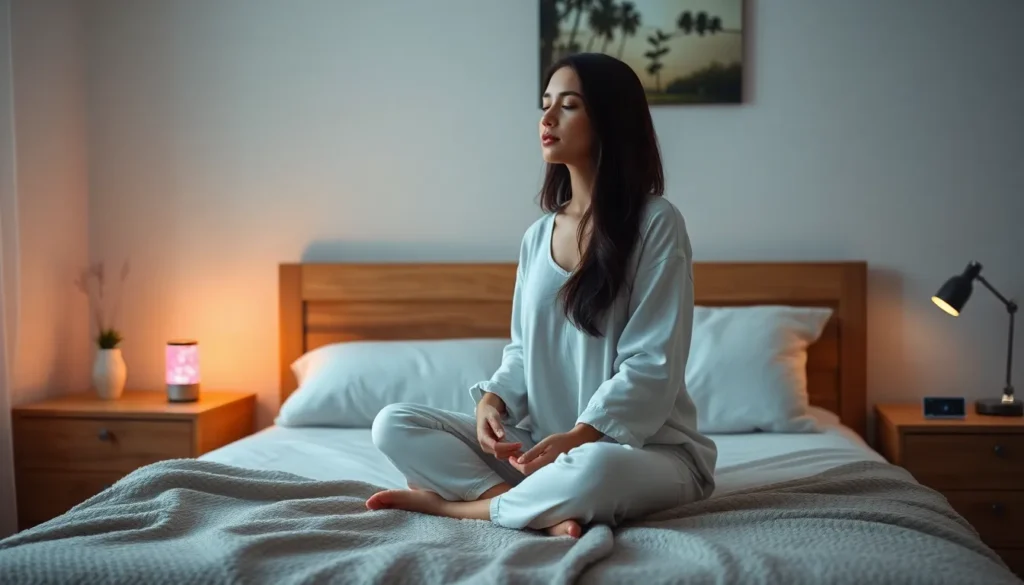Table of Contents
TogglePicture this: it’s 3 a.m., you’re wide awake, and counting sheep feels more like a part-time job than a sleep aid. If tossing and turning has become your nightly routine, it’s time to shake things up with some get back to sleep meditation. This isn’t just any meditation; it’s your ticket to snoozeville, where the only thing on your agenda is catching those elusive Z’s.
Understanding Get Back to Sleep Meditation
Get back to sleep meditation offers a practical solution for those experiencing disrupted sleep. This technique helps individuals calm their minds and return to a restful state.
What Is Get Back to Sleep Meditation?
Get back to sleep meditation refers to specific practices designed to facilitate falling asleep after waking up in the night. It combines relaxation techniques with mindful breathing, promoting tranquility and focus. Various forms may include guided imagery or soothing music. Practitioners often emphasize letting go of stress, allowing the mind to unwind and prepare for sleep once again.
Benefits of Practicing This Meditation Technique
Practicing this meditation technique provides numerous advantages. Improved sleep quality often occurs, helping individuals feel more rested. Enhanced mental clarity usually follows, as a good night’s sleep impacts cognitive function. Stress reduction results from these practices, fostering emotional well-being. Additionally, regular meditation can develop healthier sleep patterns over time, promoting consistent sleep habits.
Techniques for Effective Get Back to Sleep Meditation

Get back to sleep meditation employs various techniques to promote relaxation and facilitate a return to slumber. Breathing exercises and guided imagery serve as two effective methods in this practice.
Breathing Exercises
Breathing exercises help calm the nervous system. Practicing deep belly breathing aids in reducing anxiety and promotes relaxation. Focus on inhaling deeply through the nose for a count of four, then exhaling slowly through the mouth for a count of six. Each cycle naturally slows down the heart rate. Alternate nostril breathing can also be beneficial; it balances both hemispheres of the brain. Incorporate these exercises during wakeful moments at night to ease back into a peaceful state.
Guided Imagery
Guided imagery transports the mind to soothing environments. Employ visualization techniques to imagine serene landscapes, such as a tranquil beach or a peaceful forest, which can help shift attention away from racing thoughts. Listening to recordings from qualified instructors enhances the experience; these often feature calming narratives that lead participants through relaxing scenarios. This technique fosters a sense of calmness and reduces stress, making it easier to drift off to sleep once again.
Creating the Ideal Sleep Environment
A conducive sleep environment plays an essential role in enhancing the effectiveness of get back to sleep meditation. Optimizing the space fosters relaxation and tranquility.
Room Setup for Meditation
Keep the room dark and cool to promote restful sleep. Consider using blackout curtains and setting the thermostat between 60°F to 67°F. Create a calming ambiance with soft, inviting bedding and pillows that support comfort. Arrange the space to minimize clutter, which can lead to distractions. Sound-proofing measures, such as rugs or white noise machines, can also enhance tranquility, allowing for deeper relaxation during meditation sessions.
Recommended Sleep Aids
Incorporate essential oils like lavender or chamomile to support relaxation. These scents promote a soothing atmosphere and may contribute to improved sleep quality. Weighted blankets can provide a sense of security, helping to reduce anxiety during restless nights. Many people find that using calming music or guided meditations aids in returning to sleep. Explore apps or audio tracks designed for sleep assistance, as these can effectively enhance the meditation experience.
Daily Practices to Enhance Sleep Quality
Daily practices significantly impact sleep quality. Implementing consistent habits fosters a healthier sleep cycle.
Establishing a Sleep Routine
Creating a sleep routine aligns the body’s internal clock. Adhering to a consistent bedtime encourages the body to anticipate sleep. Incorporating relaxing activities, such as reading or taking a warm bath, signals to the mind that it’s time to wind down. Dimming lights an hour before sleep helps facilitate melatonin production. Choosing a sleep duration of 7-9 hours enhances overall well-being. Striving for a technology-free hour aids in minimizing distractions. Tracking sleep patterns with a journal identifies what works best for the individual, allowing for adjustments as needed.
The Role of Mindfulness in Sleep
Practicing mindfulness cultivates awareness of thoughts and feelings before bedtime. Engaging in mindful meditation reduces anxiety and invites relaxation. Focusing on breath, body sensations, and surrounding sounds promotes a peaceful state of mind. Utilizing guided meditations specifically designed for sleep aids in redirecting attention from stressors. Listening to calming music while practicing mindfulness can enhance the experience. Building a mindful approach towards nightly thoughts improves the ability to let go of worries, supporting the transition into sleep. Regular mindfulness practice can lead to a significant decrease in insomnia symptoms.
Embracing get back to sleep meditation can transform restless nights into peaceful slumber. By incorporating techniques like deep belly breathing and guided imagery, individuals can effectively calm their minds and ease back into sleep. Creating a soothing sleep environment and establishing a consistent routine further enhances this practice.
Integrating mindfulness into nightly rituals not only reduces anxiety but also promotes a deeper sense of relaxation. With dedication and the right strategies, anyone can improve their sleep quality and enjoy the restorative benefits of a good night’s rest.




